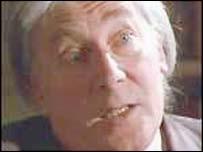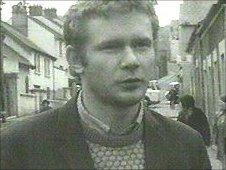Key findings
- Published

Lord Saville chaired the Bloody Sunday Inquiry
The Saville Report into the events of Bloody Sunday in Londonderry on 30 January 1972 has been published. The inquiry set out to answer a number of key questions:
Were those killed and injured all unarmed and innocent civilians?
"None of the casualties shot by soldiers of Support Company was armed with a firearm or (with the probable exception of Gerald Donaghey) a bomb of any description. None was posing any threat of causing death or serious injury. In no case was any warning given before soldiers opened fire.
"None of the casualties was posing a threat of causing death or serious injury, or indeed was doing anything else that could on any view justify their shooting."
Did the soldiers shoot in response to IRA gunfire?
"We have concluded that the explanation for such firing by Support Company soldiers after they had gone into the Bogside was in most cases probably the mistaken belief among them that republican paramilitaries were responding in force to their arrival in the Bogside. This belief was initiated by the first shots fired by Lieutenant N and reinforced by the further shots that followed soon after."
Who fired first?
On balance, Saville says a soldier fired first. "Soldiers reacted by losing their self-control and firing themselves, forgetting or ignoring their instructions and training and failing to satisfy themselves that they had identified targets posing a threat of causing death or serious injury."
The victims
Relatives of those killed on Bloody Sunday wanted Lord Saville to give official recognition they were unarmed and innocent civilians, who were unlawfully killed.
Were any of those killed or injured carrying weapons?
Saville said that none of the victims were armed "with the probable exception of Gerald Donaghy".
A police photograph showed nailbombs on Mr Donaghey's body. His family said they were planted - Saville disagreed.
But the inquiry added: "We are sure that Gerald Donaghey was not preparing or attempting to throw a nail bomb when he was shot; and we are equally sure that he was not shot because of his possession of the nail bombs. He was shot while trying to escape from the soldiers."
Was anyone other than the known dead and wounded shot?
Some soldiers have suggested the IRA spirited away their own dead. Saville said there was no evidence that anyone else had been killed on the day - and had they been, the stories would have emerged by now.
The soldiers
A key question for the inquiry was whether individual soldiers broke the law. They faced allegations that they either murdered people, fired without justification or gave false evidence.
Did the soldiers act in self-defence or did they fire indiscriminately?
Saville said the soldiers fired because they lost control. He said with the exception of two soldiers, "none of the firing… was aimed at people posing a threat of causing death or serious injury".
Should any soldiers face prosecution - and for what offence?
The Saville inquiry has not made any recommendations about prosecutions - but he singles out some of the soldiers, who cannot be named, as people who he says lied to the inquiry or did not care what happened when they opened fire.
Soldiers who appeared as witnesses were not granted immunity from prosecution; only immunity from self-incrimination. It is possible that individual soldiers could be prosecuted for their role in Bloody Sunday, but in practice this is highly unlikely.
Senior British Army officers

Derek Wilford: One of the senior officers
The inquiry also set out to establish what orders were given by army commanders and their superiors in London.
Senior officers testified in London, including the soldier in charge of the Parachute Regiment on the day, Colonel Derek Wilford, and the soldier in charge of the whole operation, Brigadier Pat MacLellan.
Were the soldiers properly prepared on the day?
"Soldiers of Support Company had been told by officers and believed that this was a particularly dangerous area for the security forces, with any incursion running the risk of meeting attacks by paramilitaries using bombs and firearms."
"If these soldiers were not frightened, they must at least have been highly apprehensive."
The report did not criticise Major General Ford, commander of land forces, for deploying soldiers to arrest rioters, but added: "his decision to use 1 Para as the arrest force is open to criticism on the ground that 1 Para was a force with a reputation for using excessive physical violence, which this ran the risk fo excerbating the tensions between the army and nationalists."
Did soldiers disobey orders?
"The soldiers of Support Company who went into the Bogside did so as the result of an order by Colonel Wilford, which should not have been given and which was contrary to the orders that he had received from Brigadier MacLellan."
Did they cover up the events of the day?
Saville concludes: "Apart from Private T many of these soldiers have knowingly put forward false accounts in order to seek to justify their firing."
The Official and Provisional IRA

Martin McGuinness confirmed he was an IRA member in 1972
Central to the soldiers' explanation of events was the claim that they were responding to IRA gunfire. Martin McGuinness was the most prominent former IRA man to give evidence to the tribunal.
Did a republican gunman fire the first shots?
Saville says that there was "some firing by republican paramilitaries" but that on balance the Army fired first.
A member of the Official IRA told the inquiry that they had shot at soldiers very early on in retaliation to the shooting of two of the protesters. Saville said: "These two Official IRA members had gone to a pre-arranged sniping position in order to fire at the soldiers; and probably did so when an opportunity presented itself rather than because two civilians had been injured."
What was the role of Martin McGuinness?
"In the course of investigating the activities of the Provisional and Official IRA on the day, we considered at some length allegations that Martin McGuinness, at that time the Adjutant of the Derry Brigade or Command of the Provisional IRA, had engaged in paramilitary activity during the day.
"In the end we were left in some doubt as to his movements on the day. Before the soldiers of Support Company went into the Bogside he was probably armed with a Thompson sub-machine gun, and though it is possible that he fired this weapon, there is insufficient evidence to make any finding on this, save that we are sure that he did not engage in any activity that provided any of the soldiers with any justification for opening fire."
The government
The shootings happened against a backdrop of worsening violence in Northern Ireland; the march was a protest against internment - a form of imprisonment without trial introduced at the height of the political and civil crisis.
Was the government responsible for the deaths?
"The immediate responsibility for the deaths and injuries on Bloody Sunday lies with those members of Support Company whose unjustifiable firing was the cause of those deaths and injuries."
Did the British government encourage the soldiers to get tough?
"In the months before Bloody Sunday, genuine and serious attempts were being made at the highest level [of the British government] to work towards a peaceful political settlement in Northern Ireland.
"Any action involving the use or likely use of unwarranted lethal force against nationalists on the occasion of the march (or otherwise) would have been entirely counterproductive to the plans for a peaceful settlement; and was neither contemplated nor foreseen by the United Kingdom Government."
Did the Northern Ireland government at Stormont want violence?
"So far as the Northern Ireland Government was concerned, although it had been pressing the United Kingdom Government and the Army to step up their efforts to counter republican paramilitaries and to deal with banned marches, we found no evidence that suggested to us that it advocated the use of unwarranted lethal force or was indifferent to its use on the occasion of the march."
Was there a shoot-to-kill policy?
"It was also submitted that in dealing with the security situation in Northern Ireland generally, the authorities (the United Kingdom and Northern Ireland Governments and the Army) tolerated if not encouraged the use of unjustified lethal force; and that this was the cause or a contributory cause of what happened on Bloody Sunday. We found no evidence of such toleration or encouragement."